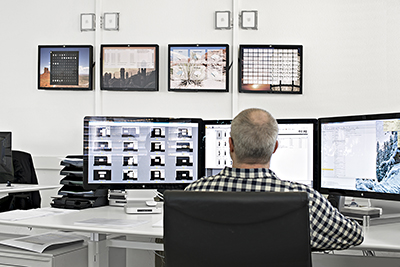
Databases are like vain divas: if you’re not nice to them, they go into a huff and shut down. And then you need support!
Digital asset management, web-to-print or PIM systems are technically highly complex databases that everyone should be able to navigate with ease and just a few clicks. This basically works perfectly in everyday life. Even faulty manipulations can’t harm a system; at worst, you get an “error” message or the user is asked to enter the data again or consult the manual. It’s only when the wrong data is entered by mistake that the system might freeze or crash. But even then, no harm has been done; at most, a bit of stress for a while. Get the support in! During a walk, Christian Seyboldt talks about his world of computers, their quirks, how he deals with them and the friendship he nurtures with them.
Interview with Christian Seyboldt in 2017, System Support at n c ag, Urdorf – Thomas Gysin
For your average IT technician, databases should actually function without errors; they are based on a system that has been carefully tested until the probability of an error source is 0.0001 percent, meaning it could never happen in a human lifetime. And if the system does actually refuse a click command, it isn’t the technology that’s failed, it’s the person operating it. So much for the logic of your average computer freak. On our walk, Christian Seyboldt takes a slightly more nuanced view, telling us a few things from his experience that we’ve probably only seen in the movies. Computer nerds will have noticed long ago that artificial intelligence has now taken on a life of its own. The countless automated processes that have been built into a system have linked themselves and developed their own memory, which is constantly updated click by click, leaving no traces and ultimately presenting technicians with unsolvable riddles. No manual can help here, and cursing certainly won’t either. The programmer has to show some humility, bow down in front of the machine, be nice and ask the machine if it can help. That’s how it is today, says Christian Seyboldt, laughing. For many, this may sound scary, but he’s been used to it for a long time, he’s been part of this development, both from the programmer angle and the perspective of the machines. Humans will have to get used to the artificial intelligence of computers, and there’s still enough time to understand computers and all their quirks, make friends with them and develop alongside them. Anyone not doing so, though, will get caught on the wrong foot sooner or later. Suddenly, instead of dealing with willing recipients of orders, they’ll be faced with machines that have taken on a life of their own, and may start making demands of their own.
Smooth and nimble operation with n c ag’s systems
When he talks about his customers’ databases, Christian Seyboldt is very enthusiastic. The software solutions from n c ag are perfectly adapted to the real needs of the respective tasks, the user interface with all the information is easy to understand, the menu navigation is self-explanatory. All of this makes work basically easy for every user, and the error rate is close to zero. The systems are based on tried-and-tested solutions, so that even potential problems don’t escalate into minor catastrophes in day-to-day operations. In most cases, support is provided by telephone or by email. If the problem is more hidden, the root cause is usually human error. An incorrectly named and wrongly stored file, for example, can only be located with a search program. He’s happy whenever he can put a smile back on the faces of despairing customers. It can take a bit longer if you have no idea who the originator and what the cause is. Not even a manual helps much then. However, the rock-solid basis of the systems used certainly benefits him. And then it’s a case of relying on logic, your own logic, i.e. human logic, and if that doesn’t help, you go for the logic of the computer brain, which works a bit differently. These moments need you to stay calm, be nice to the computer and not look for a fight with it – just talk to it. And if you’re on first name terms with your device, that helps!
With media databases, things that ate up a lot of time and money back in the analog era are now available at the click of a mouse.

In the analog days, a good-quality title setting cost five francs per letter, retouching a photo easily reached a five-figure sum, and there was no internet. If speed was essential, couriers or cabs were ordered via the landline (cell phones didn’t exist!) and getting a finished ad to be published could take up to a week. This was still the case 25 years ago! With today’s media databases, it takes just a few clicks: the ad template is designed in line with the CI, all the information with the latest offering and the right price is inserted in the right place, and with one more click the ad appears on the desktop of the employee in charge at a publishing company, even the billing process takes place automatically. That’s how it works today. Fascinating stuff! It works the same way with all means of communication. The database of n c ag customer Mövenpick Hotels & Resorts is a good example of this. Somebody somewhere in the world needs the latest room pictures for an advertisement, wants to correct a menu card, print a brochure or order new hotel signage. The networked database makes all this possible – it makes everything possible, anytime, anywhere in the world!
“It’s fun managing a tool like this and providing support,” says Christian Seyboldt, smiling. He retains a cool calmness, aware that there’s always someone who needs his help – or, worst-case scenario, that he’ll get called into action by the database itself, with it grumbling like a vain diva not happy with the attention she’s getting. What does he do then? “Stay calm and be nice to her,” says Christian. And he eats a piece of chocolate while doing so to keep all the fuss at bay.
Seyboldt’s chocolate cake

Seyboldt’s chocolate cake
Instructions for small/large mold
300 g/400 g dark chocolate, plain (70% cocoa content)
100 g/200 g butter
100 g/200 g cane sugar
5/6 (large) eggs
Melt the chocolate over hot water, melt the butter. Mix sugar and butter, add melted chocolate and stir well. Whisk the cracked eggs until foamy and fold them into the mixture. Pour into a buttered springform cake tin (small/large), bake at 180°C for 30 minutes. Allow to cool, cover and refrigerate, and serve cold.

Christian Seyboldt, Support
Christian Seyboldt originally completed the old-school repro-photographer and lithographer training and was involved gradually in the transition from analog technology to the new digital age. What really fascinated him was IT technology, and this opened up a whole new world for him. Christian Seyboldt quickly discovered, by skillfully combining a wide variety of programs and components, that it’s possible to turn a simple computer into an intelligent assistant able to perform many tasks in a work process more quickly, efficiently and precisely than a human being can. Today, he knows all the systems, shares his knowledge in training courses and is in charge of customer support. The artificial intelligence of today’s computers might manage to fire up Christian Seyboldt’s fascination every day, but he feels that humans remain the fulcrum of life. He lives with his wife and two children in the city of Zurich between the forest and the lake. Christian Seyboldt likes to travel a lot and is a passionate cook.
